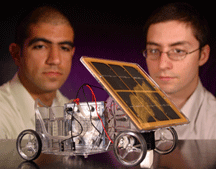Future chemical engineers race for finish line with fuel cell car

Two UH students first to go national, place high in competition
Putting the pedal to the metal, two University of Houston chemical engineering students tested their mettle with the creation of a fuel-cell-driven car in the national "Chem-E-Car" competition. The pair placed 13th among nearly 40 teams from across the country.
Testing their classroom knowledge by building shoebox-sized cars powered by chemical reactions, Mansour AbdulBaki and Adrian Morales, senior chemical engineering students and members of UH's student chapter of the American Institute of Chemical Engineers (AIChE), became the first-ever UH students to participate at the national level. After capturing a second-place finish at the regional competition during the Spring '04 semester, AbdulBaki and Morales were pleased with their national debut at the sixth annual competition this fall in Austin.
Since no one from UH had ever participated before, the students agreed that they had to initiate the process themselves, along with financial sponsorship from the UH AIChE student chapter. Successfully applying their knowledge to construct a winning racecar that took the better part of a year to build, the students were required to construct a vehicle that carried a predetermined weight a particular distance before stopping. AbdulBaki and Morales' miniature car obtained its energy from a fuel cell reaction, making it more environmentally friendly.
"We started off using a chemical battery, but it performed poorly and we eventually moved to the idea of a fuel-cell-powered car," said Morales, current vice president of the UH chapter of AIChE.
The competition requires students to use controlled chemical reactions in designing and operating shoebox-sized cars. Making things more challenging, the students are given the payload and distance that their vehicles must carry and travel only an hour before the race begins. In this case, their racecar needed to transport 400 milliliters of water 75 feet. Students also include a poster presentation demonstrating their understanding of the chemical reactions used and their attention to safety. Facing new obstacles to overcome and generating new ideas proves challenging, but the competitors have an invaluable opportunity to apply ideas learned from coursework.
"We are proud to have achieved our goals," said AbdulBaki, former president and current Web master of UH's AIChE. "We wanted to earn recognition for UH and our highly ranked, but relatively underexposed, Department of Chemical Engineering and to start a tradition of competition and achievement in our department and the UH AIChE chapter."
The next round of competitions is scheduled to begin in March and April for all nine regions throughout the nation, and the upcoming generation of UH chemical engineering students has already begun design preparations for next year's competition with a new team currently being formed.
AIChE is a professional association of more than 46,000 chemical engineers in 92 countries that use their knowledge of chemical processes to develop safe and useful products for the benefit of society.
Source: University of Houston

















